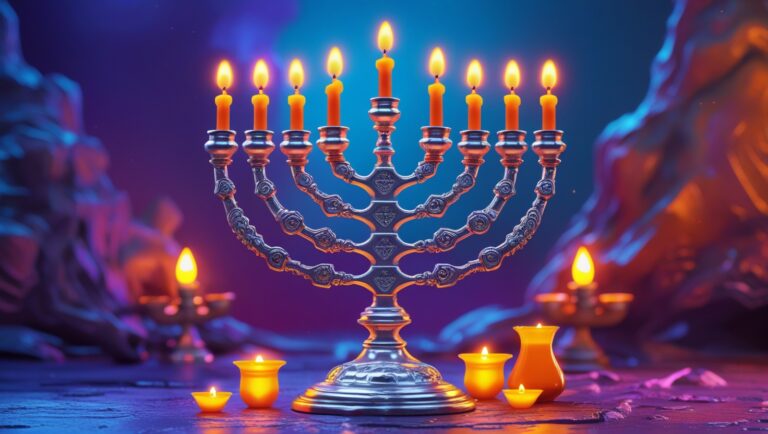The Jewish sages were a lot more powerful and wiser than most people give them credit for
Our understanding of reality is often so warped that we think that the Jewish sages were “pretty smart” but not really “very wise”. After all, they didn’t have “internet” or “schwarma” or “guns”. Well, the truth is back in the days they had an insane amount of technology we don’t dream about (because they are in movies). I know this is a very controversial idea that might sound like crazy talk, but is very logical when we consider the Kabbalistic aspect of history and the mind.
Jewish Meditation also helps us probe the depths of human experience and power of the soul to effect the physical reality. We are unfortunately subject to so much pollution our minds can’t work properly enough to see what is happening around us, and change it. I will probably write a full post on our myopic perception of the world in the near future, bli neder.
Either way, there exist profound secrets associated with these Tzaddikim (righteous individuals), both Tannaim and Amoraim, and we will attempt to shed some light on them. It’s essential to note that our explanation here is not exhaustive, as Hashem employs various events and circumstances for a multitude of purposes (so nothing is ever really for just “this one thing”).
A short introduction to the Jewish Sages
The piety of Jewish sages is often challenging to fully grasp and appreciate because many of their righteous deeds are concealed and not easily graspable. These hidden actions might leave us wondering why they are even considered significant. Furthermore, the spiritual heights they attain can seem overwhelming or even nonsensical to us, creating a sense of fear and disbelief that may keep us from drawing closer to Hashem.
Yet, they are the keepers of our tradition and its thanks to the Jewish sages throughout the generations that we have not only Rabbinical Mitzvot like Chanukkah and Purim, but even the pshat (simple meaning).
The 10 Martyrs who died during the roman persecutions are called Asara Harugei Malchut, and there are different accounts of who they were. The reason is because we have reliable sources that attest that they actually escaped death and put a doppelganger in their place. More on this later.
The identities of the perpetrators behind the murder of the ten Harugei Malchut remain shrouded in obscurity, with no discernible clues provided by the piyutim “Arzei Halevanon” and “Eileh Ezkera.” These liturgical texts, recited on Tisha B’Av and Yom Kippur, do not shed light on the when, where, or why of this event’s occurrence. This historical episode carries a veil of mystery, leaving questions about who was responsible for these deaths.
The grinder of bones
The identity of the individual responsible for the deaths of the Asara Harugei Malchut, or the Ten Martyrs, is attributed to the infamous figure known as the Wicked Andrianus, who is also commonly referred to as Hadrian. The sages of Chazal held Andrianus in such contempt for his extreme wickedness that they even termed him the “Grinder of Bones” (e.g., Bereshit Rabba 10:3).
The historical backdrop against which the tragedy of the Asara Harugei Malchut unfolded was the catastrophic Bar Kochva rebellion. This rebellion persisted for three and a half years and ultimately came to a grim conclusion with the devastating massacre at Bar Kochva’s final bastion in Beitar.
Hadrian, who ascended to the role of Caesar in the year 3877 (117 CE), faced one of his initial challenges in quelling the Quietus Rebellion, which marked the second Jewish uprising of the time, following the initial revolt of the biryonim during the period of the Churban (destruction of the Second Temple) and the subsequent third major rebellion led by Bar Kochva.
As noted in the Seder Olam Rabba, the timeline of these events is recorded: “From the War of Aspanyus (Vespasian, i.e., the Churban) until the War of Quietus was fifty-two years, and from the War of Quietus until the Last War and the War of Koziva (Bar Kochva) was seventeen years, with the War of Koziva lasting three and a half years.”
Initially, Hadrian appeared to live up to his reputation as an intelligent and cultured ruler, reminiscent of the philosopher-king archetype depicted in Greek philosophy. Throughout his rule, he generally avoided confrontations and favored diplomatic negotiations and compromise. Following the Quietus Revolt, he permitted Jewish life to resume relatively normally and even engaged in intellectual discourse with the Jewish sages, to our great surprise.
As mentioned in the Midrash (Bereshit Raba 28:3), Hadrian posed several questions to Rabbi Yehoshua, including inquiries about the resurrection of the dead in the future world. Rabbi Yehoshua responded that the Holy One would resurrect a person from the “luz” bone of the spine, as we know. This is the bone that does not rot and will be used by Hashem to reconstruct us entirely.
In another conversation, Hadrian remarked to Rabbi Yehoshua, “Great is the sheep that survives among seventy wolves,” to which Rabbi Yehoshua retorted, “Great is the shepherd who saves and breaks them before the wolves” (Esther Rabba 10:11). This, of course, is an allusion to the Jewish People who are called peaceful as sheep while our tormentors are the 70 guardian angels of the nations who incite those that are wicked against us (which, of course, is definitely not everyone).
The Kabbalah of the 10 Martyrs
The ten holy martyrs are known to have atoned for the sale of Yosef (Joseph) himself. According to the teachings of the Arizal, they each carried the Ibur (spiritual impregnation) of one of the sons of Yaakov Avinu (Jacob, their forefather). While this story is well-documented, we won’t delve deeply into it here.
The Zohar recounts a critical moment in Yosef’s life when he was on the brink of sinning with the wife of his master, Potifar. Some commentators, like Rashi, suggest that he was on the verge of succumbing to her temptations after a year of resistance. However, according to certain Breslov sources, by coming so close to sin and ultimately overcoming it, Yosef effectively “stabbed the evil inclination in the eye” and opened a new source of strength for men throughout generations to confront their own challenges.
In line with the Zohar’s teaching, as Yosef drew near to this sinful act, ten drops of semen emerged from his ten toenails. As Yosef was the quintessential Tzaddik and represented the Sephira (spiritual attribute) of Yesod, these exceptionally pure drops became the spiritual garments of the souls of the ten holy martyrs. Unfortunately, these holy garments were seized by the forces of evil and had to be atoned for with the martyrs’ lives at a later time.
The Great Rebellion
In the thirteenth year of his reign, Andrianus, after visiting Jerusalem for the first time, extended a seemingly extraordinary offer to the Jewish people: they were granted permission to rebuild their Beis Hamikdash, or Holy Temple. The Midrash (Bereshit Rabba 64:10) recounts this historical event:
“In the days of R. Yehoshua ben Chananya, the wicked kingdom (Rome) decreed that the Beit Hamikdash should be built. Papus and Lulianus, two brothers who later sacrificed their lives to save the Jews of Lod from a false accusation (as recounted in Ta’anis 18), set up tables from Acco to Antioch and provided those returning from exile to assist in the reconstruction of the Beit Hamikdash with silver, gold, and all the supplies they needed.”
However, the Midrash proceeds to explain how the Samaritans, or Kutim, warned Andrianus that the rebuilding of the Beit Hamikdash would embolden the Jews to rebel against his rule.
“‘He said to them, ‘What can I do? I have already decreed that it can be rebuilt.’ “‘They said to him, ‘Send a message instructing them either to relocate it, raise its height by five amot, or lower it by five amot. This will discourage them from proceeding with the construction.'”
This directive to alter the Beit Hamikdash’s dimensions ultimately played a role in fomenting the Bar Kochva rebellion.
According to the Roman historian Cassius Dio, another factor inciting the rebellion was Andrianus’ decision to establish a Greco-Roman city atop the ruins of Jerusalem. He named it Aelia Capitolina, incorporating elements of his name (Aelius) and an associated Greek deity. One of the most recognizable remnants of this city is the modern “Cardo” shopping center in Jerusalem’s Old City, situated not far from the Western Wall (Kotel).
This street functioned as the primary thoroughfare in Jerusalem for many centuries until the Roman city’s destruction. Following the Six-Day War, archeologists unearthed the Cardo based on historical maps, and it was subsequently redeveloped into a contemporary tourist attraction.
Cassius Dio (volume 5) asserts that the establishment of this idolatrous city also fueled the Jewish rebellion:
“In Jerusalem, he founded a city to replace the one he had razed to the ground, naming it Aelia Capitolina. On the Temple’s site, he constructed a new temple dedicated to Jupiter. This action triggered a protracted and significant war. The Jewish people found it intolerable that foreign races inhabited their city and foreign religious practices were introduced there.”
This ignited the Mered Hagadol (Great Revolt) of 3892 (132 CE), which initially enjoyed success but was ultimately crushed by a formidable Roman army, larger even than the one involved in the earlier Churban. The climactic fall of Beitar in 3895 (135 CE) was marked by extensive carnage, so much so that it was described with the imagery of horses wading through blood up to their nostrils (Yerushalmi Taanit 4:5).
Cassius Dio’s accounts state: “Fifty of their most vital fortresses and nine hundred eighty-five of their most renowned towns were obliterated. In the course of these invasions and battles, 580,000 men were killed, and the number of those who perished due to famine, disease, and fire was beyond calculation. Virtually all of Judaea was left desolate.”
In contrast to General Vespasian (Aspanyus), who allowed Raban Yochanan ben Zakai to rebuild Torah study in Yavneh following the Churban, Andrianus took a decidedly different approach. He determined that the most effective means of dealing with the Jewish populace was the complete eradication of Torah observance.
This decision was partly driven by his profound admiration for Greek culture. In his earlier years, Andrianus had such a strong affinity for Greek literature that he earned the moniker “Graeculus,” or the Little Greek. During his reign, he even sought to unify the city-states of Greece under a single parliament, though these efforts proved unsuccessful.
Dor HaShmad
In a surge of oppressive measures and retaliation, Andrianus initiated a series of anti-Torah decrees that marked the beginning of the Dor Hashmad, a generation of spiritual destruction. It is not entirely clear which decrees were enacted before the rebellion and which followed it.
In addition to fundamental prohibitions against bris mila (circumcision), Shabbat (the Sabbath), taharat mishpacha (laws of family purity), and Kiriat Shema, Andrianus abolished numerous other daily mitzvot. The Medrash (Vayikra Rabba ch. 32) documents these bans:
“R. Natan says, ‘To those who love Me and keep My mitzvot.’ These are the Israelites living in Eretz Yisrael who risk their lives for the sake of the mitzvot. ‘Why are you going to be executed?’ ‘Because I circumcised my son.’ ‘Why are you going to be burned?’ ‘Because I read from the Torah.’ ‘Why are you going to be crucified?’ ‘Because I ate matzah.’ ‘Why are you being whipped?’ ‘Because I took a lulav, built a sukkah, wore tefillin, and attached techeiles (blue fringes to my tzitzis).'”
Andrianus barred Jews from entering Jerusalem, and, for over 300 years, no Jew could pray at the Makom Hamikdash (the Temple Mount) except on Tisha B’Av, a day of mourning for the destruction of the Temple. When Andrianus exhausted his reasons for executing Jews, he was content to have them put to death without any justification. As the Midrash (Eichah Rabba 3:1) recounts:
“One day, a Jew passed by Andrianus and greeted him. Andrianus asked, ‘Who are you?’ The Jew replied, ‘I am a Jew.’ Andrianus inquired, ‘Did you see a Jew pass by and greet Andrianus?’ He then ordered, ‘Go and behead him!’ Another Jew witnessed this and refrained from greeting Andrianus.
Andrianus asked, ‘Did you see a Jew who passed by and did not greet Andrianus?’ He then ordered, ‘Go and behead him!’ An officer approached Andrianus and said, ‘We do not understand your actions. Someone who greets you is executed, and someone who does not greet you is executed as well.’ Andrianus responded, ‘Do you wish to advise me on how to eliminate my enemies?'”
It was during this period that Andrianus orchestrated the murder of the Ten Martyrs, although some opinions suggest that certain of the Ten Martyrs (Harugei Malchut) were killed at different times.
Rav Avraham Zakut, as documented in Yuchsin HaShalem (pages 25, 38), clarifies this historical timeline: “Bear in mind that you should not be misled concerning the events of the Harugei Malchut. The Kinot (elegies) in the Machzorim might create the impression that R. Akiva was executed alongside Raban Shimon ben Gamliel at the same time, but this is not the case.
Raban Shimon, the first among them, perished during the Churban, while R. Akiva met his martyrdom nearly sixty years later. The last five among them were executed when Beitar fell, a full seventy-two years after the Churban.”
The secret of the feminine and masculine waters
Understanding the “Secret of Feminine and Masculine Waters” holds great significance in Kabbalistic teachings, as it forms the foundation for comprehending many aspects of Kabbalah. This concept revolves around the interplay of two fundamental forces in the universe, often symbolized as masculine and feminine.
During the era of the Second Temple, the Jewish People faced a particularly low point in their history, and the world itself was on the verge of destruction. According to Kabbalah, when a generation lacks sufficient merit, Hashem withdraws His divine presence.
The delicate balance between reward and punishment, as well as the preservation of free choice between good and evil, relies on the interaction of these two cosmic forces. This balance is vital for the sustenance of both the physical and spiritual aspects of the world.
However, when the people lack merit, Hashem begins to withdraw His blessings, such as the presence of Tzaddikim and the birth of children, and, tragically, this eventually led to the destruction of the Second Temple. This was accomplished by the Jewish sages.
The Arizal explains that the 10 Holy Martyrs served as channels or helpers for the feminine waters, as the people were no longer capable of elevating them. These ten Jewish sages were so spiritually elevated that even their physical bodies were of higher stature than the souls of others. Their deaths were necessary to ensure the continued order of Creation and the elevation of the feminine waters.
The principle of these feminine waters and their elevation is reflected in the Shacharit prayer, specifically in the Hodu prayer containing the verse “El Nekamot Hashem, El Nekamot Hofiah” (God of Vengeance is Hashem, God of Vengeance Will Appear).
We learn from Sha’ar HaKavanot (Gate of Mystical Intentions) by Rabbi Chaim Vital, it is essential to have the mystical intention (Kavanah) that the souls of the 10 martyrs are assisting in elevating the fallen sparks into feminine waters. This intention is upheld in daily prayer, excluding Sephirat Ha’Omer and the High Holidays.
Aftermath
As previously mentioned, Andrianus generally preferred diplomacy and strategic solutions over war, and for most of his reign, many regions in his empire experienced peace and stability. The Jewish revolt was the primary military conflict during his rule. Instead of engaging in battles with the barbarian tribes in Europe and Britain, he focused on building an extensive fortification system to protect his territories, much like the modern wall being constructed in Israel.
In Europe, his forts and walls were primarily constructed from wood, but when it came to building a wall in northern England to repel the Caledonians (the Scots), there was insufficient wood available, and his soldiers resorted to stone. This structure still stands as Hadrian’s Wall, located within close proximity to Gateshead Yeshiva in northern England.
Despite the Jewish people’s suffering in Eretz Yisrael, they managed to survive and continue their scholarship, eventually recording the Mishna and Talmud Yerushalmi. This was done by the Jewish sages, the keepers of our tradition, who passed on the torch to the next generation.
This remarkable recovery can be attributed largely to the self-sacrifice (mesirus nefesh) of Rabbi Yehuda ben Bava, one of the Ten Martyrs. According to the Gemara (Sanhedrin 14a), when Andrianus prohibited smicha (ordination), Rabbi Yehuda ben Bava granted smicha to five of his disciples in defiance of the ban. To protect them as they fled from Roman authorities, he used his own body to block their pursuers and was ultimately killed by Roman spears.
These five disciples—Rabbi Meir, Rabbi Yehuda, Rabbi Shimon bar Yochai, Rabbi Yosi, and Rabbi Elazar ben Shamua—played pivotal roles in ensuring the survival and eventual revival of Torah study and observance following Andrianus’s death in 3898 (138 CE). Approximately fifty years later, around 3949 (189 CE), Rabbi Yehuda HaNassi was completing the Mishna, a monumental work that has preserved the Oral Torah (Torah Shebe’al Peh) for generations to come.
May we draw inspiration from the Jewish sages’ Mesirut Nefesh (self-sacrifice) in serving Hashem despite all difficulties.







